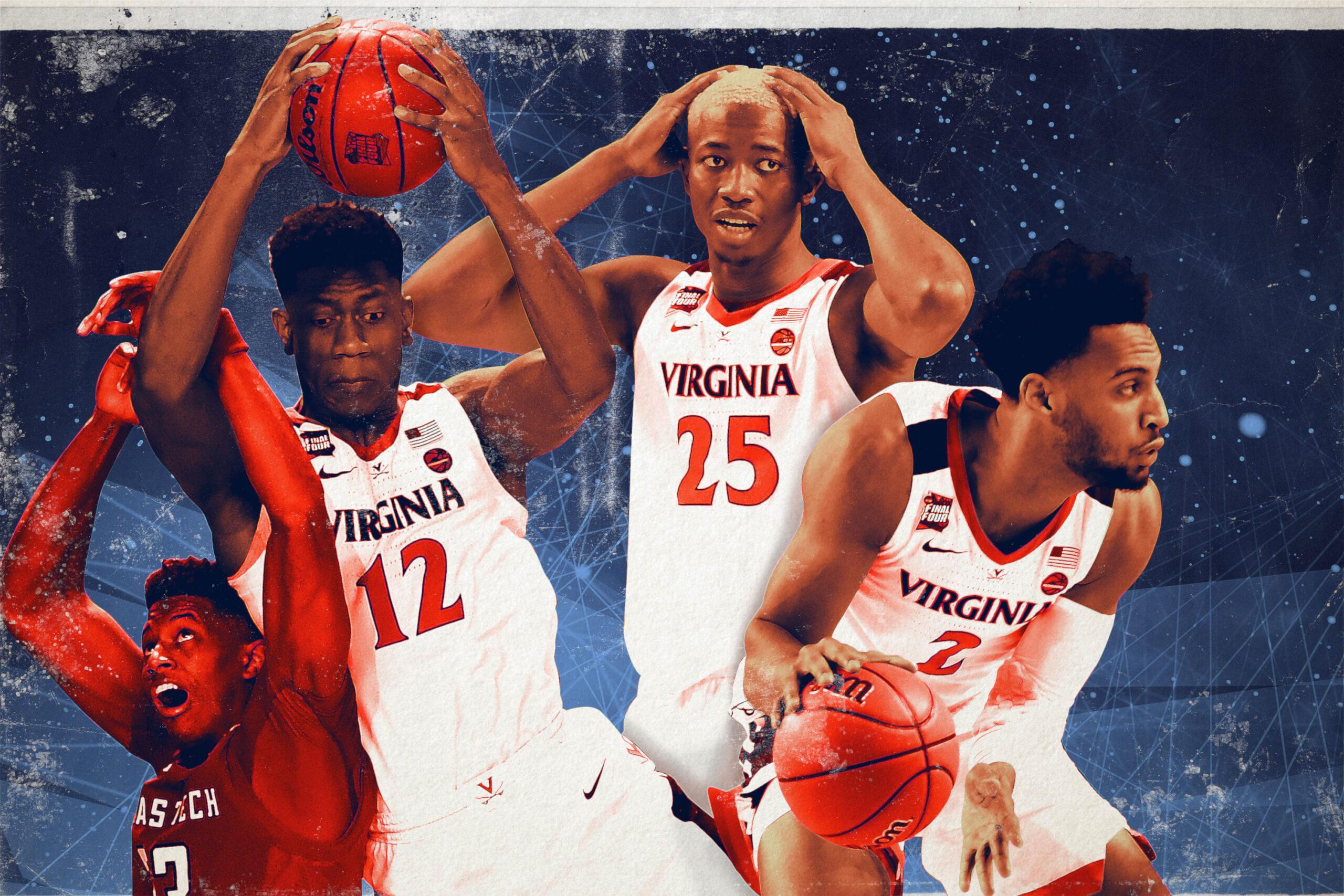Small Ball Has Arrived in the NCAA—Virginia’s Title Win Is Proof
Both the Cavaliers and Red Raiders made adjustments all tournament long that cribbed from some of the most effective postseason strategies at the pro level. Monday’s overtime thriller could be a sign of where the college game is headed.
Virginia learned the right lessons from its historic collapse in last season’s NCAA tournament. A year after the Cavaliers became the first no. 1 seed to ever lose to a no. 16 seed, they won the first NCAA championship in program history with an 85-77 OT victory over Texas Tech on Monday. Cavaliers head coach Tony Bennett didn’t alter his defensive-minded approach or glacially slow style of play, but his lineup is much smaller than it was last season. He benched his centers and started two athletic forwards (junior Mamadi Diakite and sophomore De’Andre Hunter) up front who can switch screens and defend all over the floor. Small ball has taken over the NBA in recent years. Now it has come to the NCAA.
The Cavaliers returned most of their team from last season, most notably their backcourt of senior Ty Jerome, who could go in the first round of this year’s NBA draft, and junior Kyle Guy, the hero of their 63-62 win over Auburn in the semifinal and the Most Outstanding Player of the Final Four. The biggest difference was the return of Hunter, who missed their loss to UMBC with a broken wrist. Virginia has never had a player like him under Bennett. The Cavaliers have become one of the most consistent programs in the country by building around more unheralded players, churning out second-round picks and undrafted free agents (Malcolm Brogdon, Joe Harris, Mike Scott) who have had lengthy NBA careers. Hunter, a 6-foot-7, 225-pound combo forward, will be Bennett’s first lottery pick.
Hunter had the performance of a lifetime in the national championship game, scoring 27 points on 8-of-16 shooting, including several clutch 3s, and grabbing nine rebounds. His ability to defend players at multiple positions and make spot-up 3s (career 41.9 percent from 3 on 2.3 attempts per game) gives him a high floor in the NBA, but there are legitimate questions about his ceiling. He’s a methodical player without much burst off the dribble who doesn’t make good decisions on the move: He struggled when Tech doubled him on Monday, with one assist and four turnovers. And while defense should be his calling card in the NBA, his limited block (0.6 per game) and steal (0.6 per game) numbers are red flags in most statistical models.
Virginia got the most out of Hunter by using him in the right lineups. After starting him at small forward in a bigger frontcourt next to Diakite and senior center Jack Salt in the regular season, the team downsized in the tourney, sliding Hunter from the 3 to the 4 and moving Salt to the bench. Traditional big men like Salt, who is listed at 6-foot-10 and 250 pounds, have been a huge part of Bennett’s program over the years. Salt, a willing screener who throws his body around on both ends of the floor, is the perfect fit for Bennett’s mover-blocker offense. The problem is that he doesn’t have the foot speed to defend on the perimeter, while his inability to shoot clogs up the paint. He was exposed in the Cavs’ loss to UMBC last season.
UMBC played like a modern NBA team last season, putting on a pick-and-roll clinic against Bennett’s pack-line defense. They spread the floor with shooters and forced Salt to defend point guard Jairus Lyles (who played in five preseason games for the Jazz) in space. Salt wasn’t comfortable defending outside of the paint, a glaring Achilles’ heel that was exposed at the worst possible moment for the Cavaliers last season. They looked headed for a similar fate in their first-round game against Gardner-Webb, another no. 16 seed, this season. Virginia was down 36-30 at halftime before Bennett went small in the second half, flipping a switch that he didn’t have against UMBC.
The holes in Virginia’s defense disappeared once Bennett went with a frontcourt of Hunter and Diakite. Diakite, a bouncy 6-foot-9, 228-pound big man, was more consistent than Hunter in the tourney, averaging 10.5 points on 60 percent shooting, 8.2 rebounds, 2.7 blocks, and 0.7 steals per game. His dramatic buzzer-beater at the end of regulation in their 80-75 OT win over Purdue in the Elite Eight saved the Cavs’ season, but his defensive versatility was just as important to their success. Diakite had the length, athleticism, and basketball IQ to protect the rim and seal off the lane while also being able to extend out on the perimeter. Running pick-and-rolls at Diakite and Hunter was a lost cause.
There was a dramatic difference in playing time for their three main frontcourt players between the regular season and postseason:
A Big Shift in Virginia’s Frontcourt
Even those numbers understate the change in Bennett’s substitution pattern. Salt played 34 minutes against Purdue to match up with the Boilermakers’ massive frontcourt, which featured a 7-foot-3, 250-pound starting center (sophomore Matt Haarms) and a 6-foot-9, 280-pound backup (freshman Trevion Williams). It probably wasn’t a coincidence that Virginia gave up 42 points on 14-of-25 shooting in that game to junior guard Carsen Edwards, a potential first-round pick who could run around screens and shoot off the dribble from anywhere on the floor. Salt played a total of only 22 minutes in their other five games.
Bennett coached with an urgency that many NCAA coaches don’t have in the tourney. Salt was a senior who earned playing time in the regular season for all the work that he had done in Charlottesville, but he was a liability against the best competition. Bennett operated more like the best NBA coaches in the playoffs, understanding that every minute is precious and riding his best players as far as they could take him. It was the opposite of what Michigan State head coach Tom Izzo did in last year’s second-round game against Syracuse, when he opted to leave his veteran centers in the game instead of going small to feature two future lottery picks (Jaren Jackson Jr. and Miles Bridges) up front.
The NCAA tournament is starting to look more like the NBA playoffs, with teams playing progressively smaller the deeper they advance. The Warriors are the most notable example of this trend: They hold their best lineups—with Draymond Green and Kevin Durant at the 5—in reserve until they really need them in May and June. Their traditional big men play more in the regular season to prevent their smaller frontcourt players from putting too many miles on their body in less important games. All four teams in last year’s Final Four played NBA-style offenses that spread the floor with shooters. The best NCAA defenses have had to adjust.
Both Virginia and Texas Tech had the personnel to do that. The championship game was a matchup of teams with the speed and athleticism to squeeze the life out of opponents on defense. The Red Raiders start two big men (seniors Tariq Owens and Norense Odiase), but their most common lineups were smaller units with either sophomore Jarrett Culver or senior Brandone Francis at the 4. Downsizing at power forward works because Owens, like Diakite, is a center with the athleticism to defend the 3-point line. Tech easily dispatched Buffalo, a spread pick-and-roll team that embarrassed Deandre Ayton in last year’s tourney, in a 78-58 second-round victory.
The Red Raiders went even smaller over the course of the game on Monday. They couldn’t create any offense against the Cavaliers until they benched both Owens and Odiase, who combined for only 40 minutes of playing time, and spread the floor with five perimeter players. The adjustment by Tech head coach Chris Beard gave his offense room to breathe by creating more driving lanes for Culver, who finished with 15 points on 5-of-22 shooting. The problem was that downsizing prevented the Red Raiders from putting enough size on Hunter, who was significantly bigger than any of their perimeter players.
Bennett had the winning hand. The Virginia coach didn’t have to make any major adjustments once he went to Hunter and Diakite up front. The two forwards were matchup proof. They had the strength to defend bigger frontcourts and the speed to run with smaller ones. Hunter also created mismatch problems on offense: He could take Odiase and Owens out on the perimeter, and score over Culver and Francis on the interior. While that part of his game will probably not translate to the NBA, Bennett made full use of Hunter’s abilities in the NCAA by opening up the floor for him.
To be sure, it’s dangerous to come away with too many sweeping conclusions from a one-and-done tournament. Virginia barely survived each of its last three games, and a couple of bounces the wrong way would have sent the Cavaliers home. However, all a coach can do is even the odds as much as possible by putting his players in the best position to succeed. Duke played with fire in its last-second wins over UCF and Virginia Tech, but it was only a matter of time before its luck ran out because the Blue Devils didn’t complement Zion Williamson well. Coach K never let his best player operate in as much space as Hunter does at Virginia.
Bennett isn’t coaching a traditional ACC power like Duke or North Carolina. He doesn’t have the luxury of picking and choosing the best players in the country, so he targets lower-level recruits who will be comfortable paying their dues and learning how to play in his system. There is no guarantee that he ever coaches another lottery pick like Hunter. He made the most of the opportunity that was in front of him this season. The best NCAA coaches will take notice. They don’t need to stockpile 7-footers. A team with a smaller and more versatile frontcourt just won a championship. It won’t be the last.

